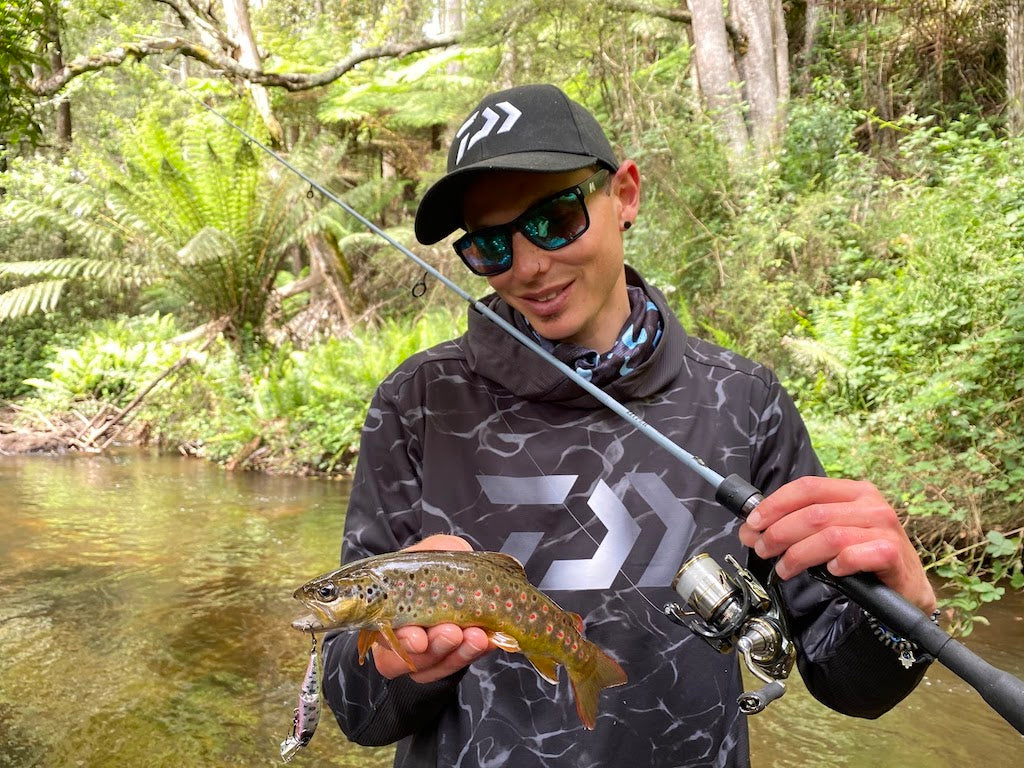How to Catch Stream Trout
By Jesse Rotin
There’s something truly soothing about the sound of running water flowing down a stream, which I believe is what hooks many of us into chasing Trout in some of the prettiest places. Alpine streams are where high concentrations of Trout occur, where the water is gin clear and cold. But keep in mind there are so many other locations like lowland creeks and rivers to streams which flow through farmland or eventually lead to the ocean, and they are all worth a look.

Finding the Trout
Streams consist mainly of shallow, fast flowing runs which eventually lead into deeper slow-moving pools. Although slow pools can be productive, it’s the fast-flowing water which tends to yield the greatest results. The reason for this is simple, flow limits the time a Trout has to decide whether it wants to eat a potential food source because if it doesn’t, it will drift away.
Naturally, Trout face into the current and use this flow to their advantage, by allowing food items to drift down to them. Swimming against flow isn’t always practical though and Trout often seek refuge behind structure which deflects the current, enabling them to preserve energy. For example, boulders, rocks, sandbars, log jams and fallen trees can all break the flow and identifying these locations in a stream are the key to finding Trout. White water which is formed by water flowing over structure can also help Trout hide and hunt undercover while furthermore disguising an angler.

Techniques
Trout have the eye for spotting a fake and if your presentation doesn’t look natural then they will generally ignore it, whether that be bait or lures.
Light line, small hooks and minimal or no weight are vital in keeping your bait presentation looking as natural as possible. Rigs do vary in streams but remember to keep the weight light to prevent snags and at times simply tying your hook straight onto your leader with no weight is enough to subdue a Trout and is my favoured way. Fishing a hook to leader rig is quite easy, you start by casting upstream and allow the flow to drift your bait down, whilst keeping a semi tight line to detect a bite. Bubble float rigs are another option which helps suspend bait up to drift at a desired depth. Fishing with Worms, especially during or after a flood is a deadly technique as freshly flooded banks often wash food items like worms and other insects into the water for the Trout to feed upon. It’s crucial at times of flood to keep your bait in close where the Trout will be hiding out of the strong flow ready to eat whatever passes by.

Spinning lures is another popular technique, which involves casting an array of lures throughout the stream. The added bonus to lures is that they often draw a territorial strike and also attract a Trouts’ attention from further afield. A straight retrieve is hard to beat, but Trout can be extremely inquisitive and follow your lure. Imparting some life into your lure with twitches can often turn a follow into a strike.

How
Stealth is the name of the game when approaching a stream and walking or wading quietly upstream will ensure you don’t spook any unsuspecting fish. Because Trout face into the current, you will need to cast your offerings in the same direction.There are certain locations which limit you from casting upstream but that’s okay because there are ways around this. Slowing your retrieve down when using lures will prevent them from wanting to break the surface of the water and following your bait as it drifts downstream will keep it looking like the real deal.
Gear
* TD Hyper 603LFS-AO (6-7ft and 1-2 or 2-4kg rods are perfect)
*Luvias FC LT 2000S and TD Kix 2500LT (1000-2500 sizes reels)
*J-Thread Nylon 6lb or J-Braid Grand 6lb (4-6lb nylon or braided line with a light leader)
Bait
*Size 8-12 baitholder hooks
*Clear bubble float
*Small sinkers or split shot
*Garden Worms, Scrub Worms, Maggots, Mudeyes and Powerbait
Lure
*Daiwa Dr Minnow 5F Jointed (all colours)
*Daiwa Presso Minnows 6F (Iwana, Black Gold, Brown Trout and Brown Sugi Shrimp)
*Daiwa Bait Junkie Minnow 2.5in (Copper Flash, Pearl Watermelon UV and Mud Blood UV) with 1/20-1/16th size 1 or 2 Jighead or Hidden Weight.
Extra Gear
*Waders and warm clothes (try not to overdress, as walking can warm you up pretty quick)
*Small Landing Net (optional)
*Backpack with food and water


